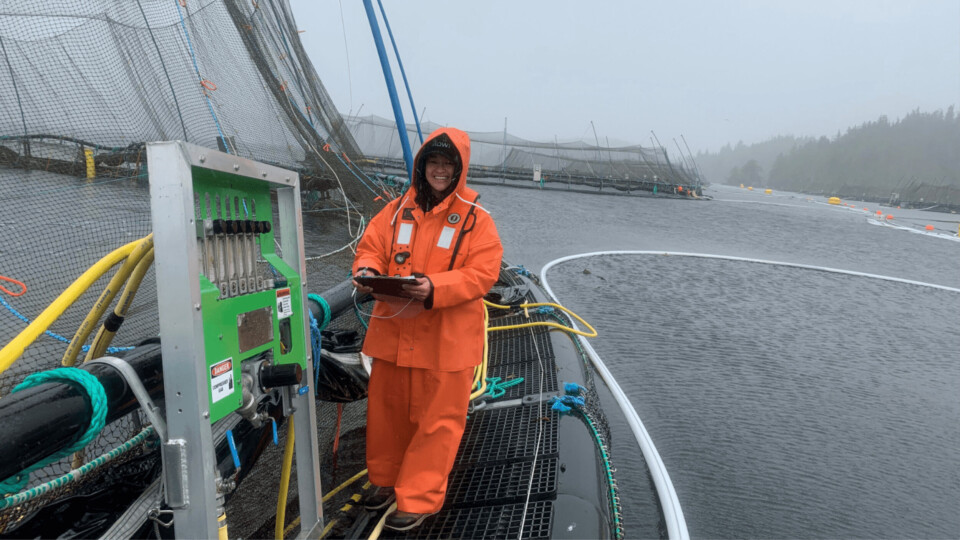
‘Change or die’ message to BC salmon industry
The Canadian government is proposing to introduce an “enhanced performance” salmon farming licence that would give producers in British Columbia longer term permits in return for adopting new technology and methods to reduce interactions with wild Pacific salmon.
The suggestion is included in a new framework for discussions that will help formulate a plan for the federal government’s policy of transition from open net pen salmon farming in the province.
The extended licence is the sweetener in a carrot-and-stick approach which would result in farmers who choose to keep farming the way they do now eventually being squeezed out by increasingly tight regulation. The government believes longer term licences will give salmon producers an incentive to invest the large amounts of money required for technology such as closed or semi-closed containment systems.
Enhanced tools
“Eligibility [for an enhanced licence] would require operators to demonstrate the adoption of enhanced tools that would be embedded in licence conditions, and to provide additional monitoring and reporting to assess their results,” wrote government department Fisheries and Oceans Canada (DFO) in the document published on Friday.
It added that the approach would create incentives for industry to invest in partnerships and new technologies and demonstrate a continual increase in environmental performance that progressively minimises or eliminates interactions between wild and farmed fish.
Some examples of the tools being suggested to support enhanced performance licences are already either common practice in salmon farming or what the industry is moving towards globally.
These include:
- Participation in area-based production planning
- Reduced overall time that farmed salmon spend in the ocean
- Implementation of innovative new technologies (semi-closed containment, etc) which would progressively minimise or eliminate interactions between wild and farmed salmon
- Participation in wild salmon monitoring or enhancement programs
Other suggestions include use of third-party observers to monitor activities for validated reporting, and a requirement to secure partnerships from those First Nations within whose territories the licensed fish farm is situated. This, too, is already the case with some First Nations.
Enhanced monitoring
The DFO is also proposing enhanced monitoring of sea lice impact, mortality, disease, escapes, wild fish in pens, and predator interactions to assess farmed salmon interactions with wild salmon and the marine environment.
“Enhanced target metrics would be set based on the best available science, with input from First Nations and stakeholders, and could vary based on coastwide or regional environmental, social, and technical factors. They could also be temporal in nature (for example, specific measurements to demonstrate performance during the wild Pacific salmon outmigration period),” wrote the DFO.
The document also acknowledges that First Nations are split over salmon farming, with some – mainly on the coast – benefiting from the income and work the industry brings, and others inland blaming salmon farms for a decline in wild salmon populations.
“Indigenous peoples have spoken clearly to the Government of Canada, articulating the need to have a broad cross-section of Indigenous voices play a key role in deciding and defining the future of salmon aquaculture in BC,” wrote the DFO.
“A transition plan should reflect the input and interests of Indigenous peoples, coastal and non-coastal alike. It should clearly outline the manner in which Indigenous knowledge is incorporated into the management of aquaculture and provide a framework which facilitates collaborative governance of aquaculture management in a manner that actively engages Indigenous peoples in a way that they feel best accommodates their rights, Title, and unique relationship with the Governments of Canada and British Columbia. This holds true for First Nations with aquaculture on their territories, as well as for First Nations in whose territory salmon are born and return to spawn.”
Four-stage discussions
The framework document sets out a four-stage timetable of engagement and consultation on the development of the transition plan. Phase 1, focused on virtual workshops for First Nations, Indigenous organisations, industry, conservation groups and local governments in BC and an online survey for the public, has already started and will run until September.
Phase 2, from September to December, will provide opportunities for detailed dialogue and the exchange of ideas through workshops, roundtables, and meetings.
Phase 3, from January to March 2023, will be available for all interested First Nations who want to continue their dialogue with the DFO to ensure that they are thoroughly engaged and consulted in discussions related to potential outcomes of a transition plan, and Phase 4, from March to June, will be a continuation of consultations, but more focused on addressing specific concerns and that perspectives are meaningfully considered in drafting the final transition plan.
Peer-reviewed science
The BC Salmon Farmers’ Association said it was pleased to read language in the government’s proposed transition discussion framework “that aligns with our current operational values”.
“While elements of the proposed framework are challenging, given the ambitious timeline set out, we are encouraged that the federal government will rely on reconciliation and peer-reviewed science as a foundation for planning,” said the BCSFA.
It added: “We are encouraged to hear DFO intends to listen to First Nations, local, and provincial governments and we will have more to contribute in the days and weeks ahead after reviewing the proposed framework in more detail.”
Read the discussion framework in full here.























































